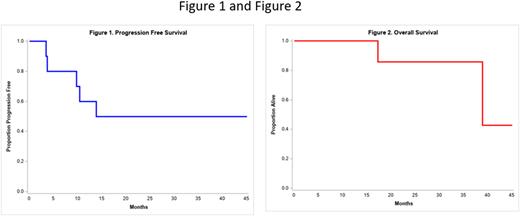Abstract
BACKGROUND PDE4 inhibition is a biologically well-informed strategy with activity in B-cell malignancies including diffuse large B-cell lymphoma (DLBCL) (PMID: 15331441, PMID: 26503641). Roflumilast (R) is a PDE4 inhibitor, currently FDA-approved for COPD (PMID: 26338438 ). Building on preclinical and clinical activity of R in B-cell lymphomas, both alone and in combination with other agents (PMID: 27756749); a phase 1 evaluation was conducted, adding R to rituximab plus cyclophosphamide, doxorubicin, vincristine, and prednisone (R-CHOP) in patients with untreated high risk DLBCL.
METHODS: This is a single center, phase 1b, open label, non-randomized, single arm, investigator initiated trial (IIT) of R + R-CHOP (RR-CHOP) for treatment naïve high-risk DLBCL patients. Key eligibility criteria included: non-GCB DLBCL (Han's algorithm), NCCN-IPI risk score of ≥ 2, Ann Arbor stage II-IV; key exclusion criteria include active CNS involvement and documented history of severe depression (a specific concern related to the use of PDE4 inhibitors). Patients received R-CHOP every 21 days for 6 cycles and R PO daily (500 mcg), throughout the 18-week treatment period. Paired germline-tumoral exome sequence was completed for 70% of patients enrolled in the trial, and DLBCL genetic subtype defined by the probabilistic classification tool LymphGen (PMID: 32289277). Primary end point was assessment and grading of adverse events (AE) according to the CTCAE version 4.03 criteria. Eligible patients were included in the intent-to-treat analysis. Secondary end points were estimation of complete response (CR) as per Lugano criteria, progression free survival (PFS), overall survival (OS) and their relationship to DLBCL genetic subtypes.
RESULTS: Ten patients met eligibility criteria for enrollment. Sixty percent were male, 50 % were Hispanics (HI), median age at diagnosis was 59 years old (y.o) (33 y.o-79 y.o), 50% were stage 2, and 50% were stage 3-4; 50% received CNS prophylaxis given high risk and 70% had International Prognostic Index (IPI) scores of 3 to 5. Standard doses of R-CHOP were able to be delivered safely, with addition of 500 mcg of R on daily basis. Regarding hematologic adverse events (AE); 1 patient (10%) experienced neutropenia grade 3, and two patients (20%) had neutropenia grade 2. Anemia occurred in 2 patients (20%), all grade 1-2. Regarding non-hematologic AE; anorexia occurred in 40% of the cohort, all grade1; diarrhea occurred in 50%, all grade 1; headache occurred in 60%, with 40% being grade 2, and 20% being grade 3, with the latter judged to be unrelated to RR-CHOP by the investigators. Forty percent had grade 1 increase of BNP; 40% of patients had nausea, 30% being grade 1-2, and 10% being grade 3; and 40% experienced weight loss, all grade 1-2.
Of 10 enrolled patients, 9 were found evaluable for assessment of efficacy, with 66% achieving CR, 22% partial response and 11 % stable disease. At 50 months of follow up, PFS was 60% at 1 year (y) and 50% at 2 y. Median PFS was not reached. OS was 100% at 1 y and 86% at 2 y, with a median OS of 38.9 months. (Figure 1 and Figure 2). The recommended R dose for phase 2 is 500 mcg PO daily.
LymphGen assigned the DLBCLs in this cohort to the A53, MCD, EZB and B2N subtypes. Notably, 3 of the 3 DLBCLs in our cohort classified as MCD or A53 DLBCLs, which normally predict poor outcome, reached CR and are long term responders. Examination of 461 primary DLBCLs (NCBI dbGaP Genomic Variation in DLBLC cohort) uncovered significantly higher PDE4B expression in in the MCD subtype, suggesting that addition of R may be particularly beneficial in this DLBCL subset.
CONCLUSION: Phosphodiesterase Inhibition in DLBCL is a well biologically informed strategy with the potential to enhance and perhaps optimize the duration of responses to R-CHOP. On this difficult to treat subgroup of non-GC DLBCL, with known subpar outcomes, RR-CHOP demonstrated to be safe, with manageable AEs that did not differ from what we have historically seen with R-CHOP alone. Early efficacy data from this combination shows 10% improvement compared to our own institutional historical controls of treatment naïve non-GC DLBCL patients treated with R-CHOP. Based on this data, we are pursuing a phase 2 multisite IIT of RR-CHOP in patients with newly diagnosed high risk DLBCL. Despite the small size cohort, our data suggest that tailoring this strategy to the poor outcome MCD/A53 genetic subgroups may increase the likelihood of success.
Disclosures
Diaz Duque:Incyte: Consultancy; Epizyme: Consultancy; ADCT: Consultancy; Astra Zeneca: Consultancy; Morphosys: Consultancy.
Author notes
Asterisk with author names denotes non-ASH members.


